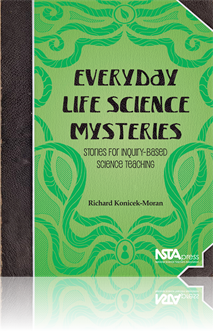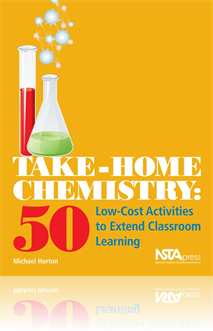All Book Chapters
Book Chapter
Students may well have the usual “bigger is better” conception about comparing different items. Pumpkins are the perfect object to help engage students in investigative science and answer most of their questions by direct observation....
Book Chapter
Children may not be aware of what is exactly happening when they have their pulse taken by a doctor or nurse or even why it is important. The story in this chapter is aimed at helping children discover what kinds of activities change their heart rate...
Book Chapter
Most students are totally unaware of the amount of sugar in bubble gum and don’t know that they are literally eating sugar in huge amounts. In this chapter, the author is concerned with finding out what happens to the weight of gum when it is chewe...
Book Chapter
Just what kinds of characteristics do living things receive from their parents and what kinds of traits do they not? What makes the offspring of any animal or plant have the basic characteristics of the parents? There happen to be a great number of h...
Book Chapter
Hardly a day goes by without something arriving by e-mail or being posted on the internet that just doesn’t sound true. The students in this story are depicted as having alert skepticism about things that don’t actually add up in their minds and ...
Book Chapter
Students may have the impression that all kinds of reaction time responses can be improved through practice. They may believe also that every kind of stimulus produces the same kind of reaction time. The story, in the chapter, provides the opportun...
Book Chapter
Segmented worms are considered “yucky” by a great many people, yet they are members of a large animal group that populates the entire world and provides a great service to our planet. This story should stimulate students to want to know more abou...
Book Chapter
This story is true, although Maria and Enrique are fictional characters. A barred owl does live in the rafter of the chickee at Shark Valley and does drop owl pellets from its nest almost daily. The purpose of this story is twofold: (1) to learn more...
Book Chapter
The story, in this chapter, is meant to show students the importance of leavening agents in making baked goods. Yeast, a living organism (a fungus), is necessary for baking risen yeast breads. This fungus can be ineffective if it is not healthy. The ...
Book Chapter
The mystery here has a lot to do with the life cycle of the insect in the cereal and what the various stages were that Emma found in the box. However, it is important that children get to know more about the most populous animals on our planet. It is...
Book Chapter
Lichens are everywhere, yet most people fail to notice them because they are so familiar. The story in this chapter was written to help persuade teachers to acquaint their students with these unique forms of life. Many biology teachers tend to gloss ...
Book Chapter
Assessing and Addressing Student Science Ideas
Our students are not blank slates. They come to school with a wide range of experiences that have shaped their science understandings—reading books, watching TV, and playing video games. From many years of research about student science ideas, it i...
Book Chapter
Balancing Chemical Equations Simulation
In this activity, students will use paper cutouts to simulate chemical reactions and balancing products and reactants...
Book Chapter
In this activity, students will measure the expansion and contraction of a balloon as it is cooled and heated....
Book Chapter
In this activity, students calculate how many moles of salt and sugar are contained in packets....
Book Chapter
Classifying Birds in the United States
The purpose of the activity, in this chapter, is to help students understand (1) what counts as a species in the field of biology, (2) some of the various definitions for species that can be used by biologists, and (3) the challenges associated with ...
Book Chapter
Characteristics of Viruses (Characteristics of Life)
The purpose of this activity is to help students understand how biologists distinguish between living and nonliving objects. It can also be used to introduce cell theory. This activity will help students learn how to engage in practices such as const...
Book Chapter
Spontaneous Generation (Cell Theory)
The purpose of this activity, in this chapter, is to help students understand that all life on Earth arises only through the reproduction of preexisting life and not from nonliving materials. This “life from life” principle is called biogenesis....
Book Chapter
Movement of Molecules In or Out of Cells (Osmosis and Diffusion)
The purpose of this activity is to help students understand the process of osmosis and to understand how a cell membrane acts as a selective barrier. This activity also helps students learn how to engage in practices such as using planning and carryi...
Book Chapter
Liver And Hydrogen Peroxide (Chemical Reactions and Catalysts)
The purpose of this activity is to help students understand that most cell functions involve chemical reactions and many reactions (including decomposition and synthesis) are made possible by enzymes. This activity also helps students learn how to en...
Book Chapter
Cell Size And Diffusion (Diffusion)
The purpose of this activity is to help students understand passive transport in cells (i.e., diffusion and osmosis) and how the size of a cell can impact the time it takes for important molecules to diffuse through a cell. This activity also helps s...
Book Chapter
Environmental Influence on Genotypes and Phenotypes (Genetics)
The purpose of this activity is to help students understand Mendelian genetics and how the environment can influence the phenotypes of organisms. This activity also helps students learn how to engage in practices such as using mathematics and computa...
Book Chapter
Hominid Evolution (Macroevolution)
The purpose of the activity, in this chapter, is to help students understand hominid evolution and to recognize the challenges of identifying evolutionary relationships between hominid species using fossils. This activity also helps students learn ho...
Book Chapter
Plants and Energy (Respiration and Photosynthesis)
The purpose of this activity is to help students understand how plants use photosynthesis to convert carbon dioxide into sugar and then use cellular respiration to convert the sugar into a useable form of energy. This activity also helps students lea...
Book Chapter
Healthy Diet And Weight (Human Health)
The purpose of this activity is to help students understand the relationship between diet, exercise, weight, and body mass index. This activity also helps students learn how to engage in scientific practices such as using planning and carrying out in...
Book Chapter
Color Variation In Venezuelan Guppies (Mechanisms of Evolution)
The purpose of the activity, in this chapter, is to help students understand how natural selection, sexual selection, and the interplay between these two mechanisms can shape the traits of a population found in different habitats over time. This acti...
Book Chapter
Termite Trails (Animal Behavior)
The purpose of this activity is to help students understand that some organisms, such as termites, have instinctive inherited behaviors. These inherited instinctive behaviors, which evolved over time through the process of natural selection, had a po...
Book Chapter
Misconception About Theories and Laws (Nature of Science)
The purpose of the activity, in this chapter, is to help students understand that theories do not become laws in science and that there is no hierarchal relationship between these two types of scientific knowledge. This activity is also designed to a...
Book Chapter
Misconception About the Nature of Scientific Knowledge (Nature of Science)
Many people believe that scientific knowledge is absolute. They think of it as something that has been proven true and as a result, it cannot or will not change. The purpose of this activity is to help students understand that scientific knowledge is...
Book Chapter
Misconception About the Work of Scientists (Nature of Science)
Many people think that the work of scientists is procedural in nature. They think that scientists use the same techniques to collect or analyze data or follow the same routine for all investigations. The purpose of the activity, in this chapter, is t...
Book Chapter
Misconception About the Methods of Scientific Investigations (Nature of Science)
The purpose of this activity is to help students understand that scientists plan and carry out many different types of scientific investigations, and as a result, there is not one single scientific method that all scientists must follow. This activit...
Book Chapter
Misconception About Life On Earth (Evolution)
The purpose of this activity is to help students understand biological evolution and the mechanisms that drive it. This activity is also designed to address many of the Common Core State Standards for English Language Arts and Literacy, which have a ...
Book Chapter
Misconception About Bacteria (Microbiology)
The purpose of this activity is to help students learn about the wide diversity of bacteria found on Earth and some of the roles bacteria play in biological systems. This activity is also designed to address many of the Common Core State Standards fo...
Book Chapter
Misconception About Interactions That Take Place Between Organisms (Ecology)
The purpose of this activity is to help students understand some of the different types of interactions that can, and do, take place between organisms within an ecosystem. This activity is also designed to address many of the Common Core State Standa...
Book Chapter
Misconception About Plant Reproduction (Botany)
The purpose of this activity is to help students understand plant reproduction and the difference between sexual and asexual forms of reproduction. This activity is also designed to address many of the Common Core State Standards for English Language...
Book Chapter
Misconception About Inheritance of Traits (Genetics)
The purpose of this activity is to help students understand that acquired traits, such as injuries and specific skills, are not passed down from parent to offspring. This activity is also designed to address many of the Common Core State Standards fo...
Book Chapter
Desert Snakes (Mechanics Of Evolution)
In this chapter, the purpose of the activity is to help students understand how natural selection can shape the traits of a population found in different habitats over time and how aposematic coloration (i.e., the bright colors of bad tasting or veno...
Book Chapter
Misconception About Insects (Ecology)
The purpose of this activity is to help students learn about the important role that insects play in ecosystems and the specific role that termites, which are often viewed as a nuisance, play in specific ecosystem. It is specifically meant to help st...
Book Chapter
The purpose of the activity, in this chapter, is to help students understand Mendelian genetics (including the law of segregation and the law of independent assortment) and several different patterns of inheritance (such as dominant-recessive, co- do...
Book Chapter
DNA Family Relationship Analysis (Genetics)
The purpose of the activity, in this chapter, is to help students understand the molecular basis of heredity and the role that DNA technology can play in solving social problems. This activity also helps students learn how to engage in practices such...






